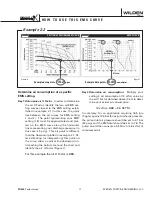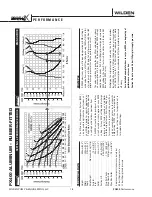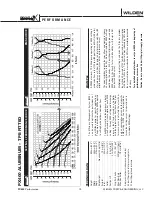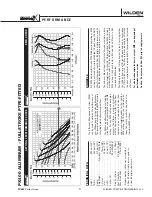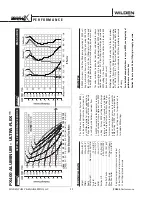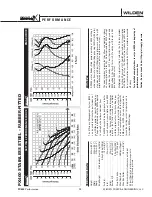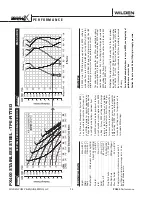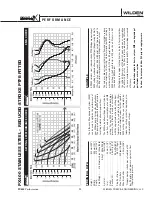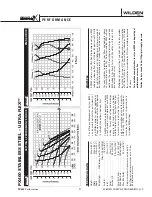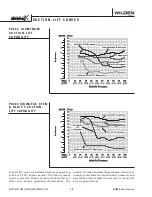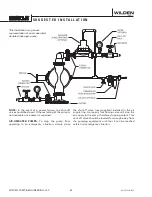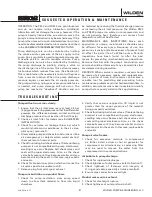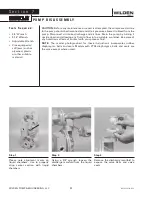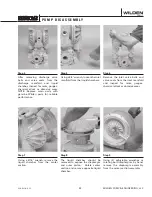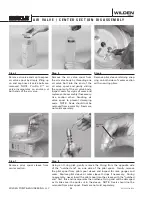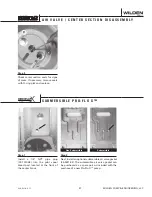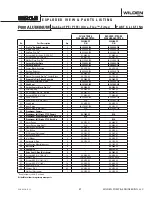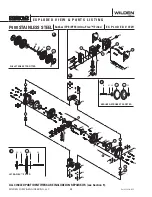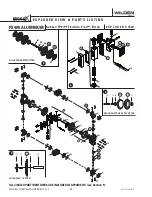
WIL-11210-E-15
31
WILDEN PUMP & ENGINEERING, LLC
S U G G E S T E D O P E R A T I O N & M A I N T E N A N C E
OPERATION: The P400 and PX400 are pre-lubricated,
and do not require in-line lubrication. Additional
lubrication will not damage the pump, however if the
pump is heavily lubricated by an external source, the
pump’s internal lubrication may be washed away. If the
pump is then moved to a non-lubricated location, it may
need to be disassembled and re-lubricated as described
in the ASSEMBLY/DISASSEMBLY INSTRUCTIONS.
Pump discharge rate can be controlled by limiting
the volume and/or pressure of the air supply to the
pump. An air regulator is used to regulate air pressure.
A needle valve is used to regulate volume. Pump
discharge rate can also be controlled by throttling
the pump discharge by partially closing a valve in
the discharge line of the pump. This action increases
friction loss which reduces flow rate. (See Section 5.)
This is useful when the need exists to control the pump
from a remote location. When the pump discharge
pressure equals or exceeds the air supply pressure,
the pump will stop; no bypass or pressure relief valve
is needed, and pump damage will not occur. The
pump has reached a “deadhead” situation and can
be restarted by reducing the fluid discharge pressure
or increasing the air inlet pressure. The Wilden P400
and PX400 pumps run solely on compressed air and
do not generate heat, therefore your process fluid
temperature will not be affected.
MAINTENANCE AND INSPECTIONS:
Since each
application is unique, maintenance schedules may
be different for every pump. Frequency of use, line
pressure, viscosity and abrasiveness of process fluid
all affect the parts life of a Wilden pump. Periodic
inspections have been found to offer the best
means for preventing unscheduled pump downtime.
Personnel familiar with the pump’s construction and
service should be informed of any abnormalities that
are detected during operation.
RECORDS: When service is required, a record should
be made of all necessary repairs and replacements.
Over a period of time, such records can become a
valuable tool for predicting and preventing future
maintenance problems and unscheduled downtime. In
addition, accurate records make it possible to identify
pumps that are poorly suited to their applications.
T R O U B L E S H O O T I N G
Pump will not run or runs slowly.
1. Ensure that the air inlet pressure is at least 0.4 bar
(5 psig) above startup pressure and that the differential
pressure (the difference between air inlet and liquid
discharge pressures) is not less than 0.7 bar (10 psig).
2. Check air inlet filter for debris (see SUGGESTED
INSTALLATION).
3.
Check for extreme air leakage (blow by) which
would indicate worn seals/bores in the air valve,
pilot spool, main shaft.
4. Disassemble pump and check for obstructions in the
air passageways or objects which would obstruct
the movement of internal parts.
5. Check for sticking ball check valves. If material being
pumped is not compatible with pump elastomers,
swelling may occur. Replace ball check valves and
seals with proper elastomers. Also, as the check
valve balls wear out, they become smaller and can
become stuck in the seats. In this case, replace balls
and seats.
6. Check for broken inner piston which will cause the
air valve spool to be unable to shift.
7. Remove plug from pilot spool exhaust.
Pump runs but little or no product flows.
1.
Check for pump cavitation; slow pump speed
down to allow thick material to flow into liquid
chambers.
2. Verify that vacuum required to lift liquid is not
greater than the vapor pressure of the material
being pumped (cavitation).
3. Check for sticking ball check valves. If material being
pumped is not compatible with pump elastomers,
swelling may occur. Replace ball check valves and
seats with proper elastomers. Also, as the check
valve balls wear out, they become smaller and can
become stuck in the seats. In this case, replace balls
and seats.
Pump air valve freezes.
1.
Check for excessive moisture in compressed
air. Either install a dryer or hot air generator for
compressed air. Alternatively, a coalescing filter
may be used to remove the water from the
compressed air in some applications.
Air bubbles in pump discharge.
1. Check for ruptured diaphragm.
2. Check tightness of outer pistons (refer to Section 7).
3.
Check tightness of fasteners and integrity of
O-rings and seals, especially at intake manifold.
4. Ensure pipe connections are airtight.
Product comes out air exhaust.
1. Check for diaphragm rupture.
2. Check tightness of outer pistons to shaft.
Summary of Contents for Wilden Advanced P400
Page 15: ...PX400 M E T A L P X 4 0 0 P E R F O R M A N C E WIL 11210 T 05 ...
Page 41: ...N O T E S ...
Page 52: ...N O T E S ...
Page 53: ...N O T E S ...
Page 54: ...N O T E S ...

